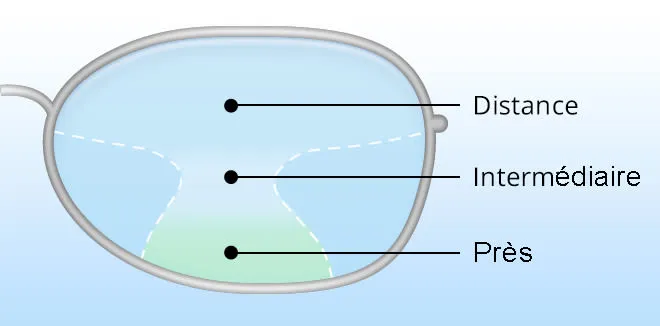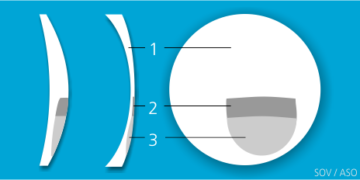What are progressive glasses?
Multifocal or progressive lenses? There's a lot of confusion when it comes to these types of eyewear. Whether or not you're familiar with the subtleties of this vision accessory, today we're going to take a look at what progressive glasses are, and how they differ from their multifocal counterparts.

What are progressive lenses?
Definition:
Progressive lenses are corrective lenses designed to correct presbyopia as well as other vision problems such as myopia, hyperopia and astigmatism. They offer visual correction at several distances without dividing lines, unlike traditional bifocal or trifocal lenses, which feature visible dividing lines.
Want to enjoy the benefits of these versatile lenses? Discover Nooz multi-distance lenses today.

Here are the main features of progressive lenses:
- Near vision zone: located in the lower part of the lens, this zone is used for reading or short-distance activities.
- Intermediate vision zone: located in the center of the lens, this zone enables clear vision at medium distances, such as when working on a computer, chatting with someone or looking at the dashboard of your car.
- Distance vision zone: located in the upper part of the lens, this zone is dedicated to distance vision, such as watching the road while driving or watching television.

The strengths of progressive lenses
- Smooth transition: progressive lenses offer a smoother transition for the eyes between different viewing distances.
- Aesthetics: they resemble single vision lenses, as they lack the distinct lines of bifocal or trifocal lenses, making them more aesthetically pleasing.
- Versatility: a single lens can correct several vision problems, so there's no need to change glasses for different tasks, as with single vision reading glasses, for example.
Disadvantages of progressive lenses
- Adaptation: for some people, it can be difficult to get used to progressive lenses because of the need to move the head to find the right angle of vision.
- Cost: they are generally (much) more expensive than bifocal or single vision lenses.

What's the difference between progressive and multifocal lenses?
Big question! The terms “progressive glasses” and “multifocal glasses” are often used interchangeably... because the two terms cover more or less the same thing. Yet there are subtle distinctions between them!
Progressive lenses
Progressive lenses are in fact a specific type of multifocal glasses. As explained above, they correct many of the shortcomings of multifocal lenses. For example, they have no visible dividing line. They also enable a smoother, more gradual transition between the different correction zones.
Enjoy absolute vision comfort now with Nooz multi-distance glasses.
Multifocal glasses
Multifocal” is a more general term that includes several types of corrective lenses (and may also include the progressive lenses presented above).
In addition to progressive lenses, these types of lenses include:
Bifocal lenses:
- Features: they have two distinct correction zones, usually separated by a visible line. The upper part is for distance vision and the lower part for near vision.
- Advantages and disadvantages: although less costly and easier to fit for some, they do not correct intermediate vision, and the visible dividing line can have an aesthetic impact.
Trifocal lenses :
- Features: these lenses include three correction zones (distance, intermediate and near) with two visible lines separating them.
- Advantages and disadvantages: like bifocals, these lenses are easy to adapt to, but have prominent lines and may not offer as smooth a transition as progressive lenses.

Main differences
To sum up, the main differences between progressive lenses and other types of multifocal lenses lies in their design. Here are their main features and differences:
- Progressive lenses: smooth transition without visible lines, covering all depths of vision. No visible separation on the lenses; more aesthetic.
- Other multifocal lenses (bifocal, trifocal): clear separation between the different corrections, with visible lines. These lenses are generally less expensive, but less aesthetically pleasing.
How much do progressive lenses cost?
Progressive lenses are an improvement on traditional multifocal lenses. Their price is therefore generally higher, although this obviously depends on their quality and brand.
Estimated prices
- Basic progressive lenses: around €150 to €300 for a pair of lenses. These lenses offer standard correction with no additional options.
- Mid-range progressive lenses: around €300 to €500 for a pair. These lenses often include anti-reflective and scratch-resistant coatings.
- Top-of-the-range progressive lenses: around €500 to €800 or more for a pair. They generally include advanced technologies, high-quality materials and additional treatments (such as photochromic or blue light coatings).
- Frames: the cost of frames also varies, and can range from €50 for basic frames to several hundred euros for designer brands.
Discover Nooz multi-distances, the new benchmark in progressive eyewear
Enjoy the comfort of clear vision at distances of up to 3 meters, without the adaptation difficulties associated with progressive lenses.
With variable correction on the top of the lens, Nooz offers clear vision up to 3 meters, ideal for computer use, cooking or meetings. The lower part of the lens ensures comfortable close-up reading.
Discover the Nooz multi-distance lenses now.
 Designed with a correction adapted to near vision, Nooz's multidistance glasses enable much easier accommodation!
Designed with a correction adapted to near vision, Nooz's multidistance glasses enable much easier accommodation!
Problems with standard reading glasses :
- Lack of versatility
- Blurred vision from 60cm
- No comfort at mid-distance.

Available without a prescription, Nooz's brand-new eyewear accessories enable easy, natural accommodation thanks to low degression adapted to proximity.
Advantages :
- The price: multi-distances come at the unbeatable price of 59 euros.
- The brand: Nooz is a Belgian brand renowned for its inventiveness and the quality of its eyewear.
- The innovation: lenses that combine the versatility and aesthetics of progressives, with a speed of adaptability superior to standard progressive lenses.
Enjoy absolute visual comfort now with Nooz multi-distance glasses.

Conclusion
In this article, we have seen that progressive lenses offer a versatile and aesthetic solution for those suffering from presbyopia, enabling clear, uninterrupted vision at all distances. We hope we've whetted your appetite for this practical and versatile solution. See you soon for more feature articles!







